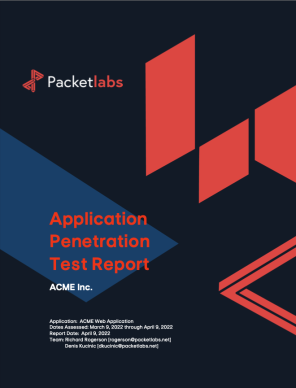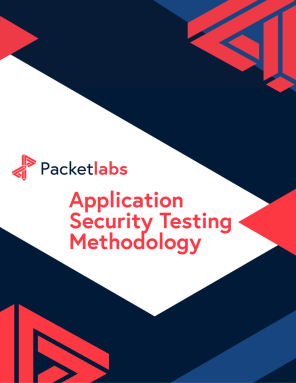Application Penetration Testing
Application Penetration Testing
Find and fix hidden vulnerabilities in your application code before attackers do.
Your apps drive revenue and trust, yet hidden logic flaws and silent API gaps can turn them into an attacker’s easiest win. Packetlabs steps in as your guide with an OWASP‑aligned, 100% tester‑driven assessment led exclusively by OSCP‑certified penetration testers..
We map every route, break past the OWASP Top 10, and chain “mind‑bending” business‑logic exploits that scanners miss. Then, the moment each issue is found, we hand you a clear remediation plan to ensure you can release with confidence.
What's included:
Thorough mapping of in-scope pages and endpoints
Automated scanning and validation of findings
Manual discovery of up to 200 types of vulnerabilities across 10+ categories
Demonstrated impact to help with executive and developer buy-in
Comprehensive reporting with detailed step-by-step instructions to reproduce
Advisory on remediation steps and retesting to validate closure of findings
Contact Us
Speak with an Account Executive
Certifications
Application Penetration Testing Service Highlights

Configuration Management
Assess supporting infrastructure and application configuration for weaknesses

Authentication
Test for password policies and reset functionality

Error Handling
Ensure the application reacts appropriately to unwanted data

Identity Management
Assess account creation and enumeration possibilities

Input Validation & Client-Side
Test for insecure coding practices that could lead to injection attacks

Session Management
Test for weaknesses in the session management schema

Cryptography
Identify weaknesses for cryptographic attacks

Business logic
Prevent application misuse by ensuring business logic is secure within each flow

Authorization
Identify misconfigurations in the authorization schema to prevent privilege escalation
Which Application Pentest is right for you?
Not sure whether a standard web application pentest is enough or if a whitebox approach would provide better insights? The table below highlights the key differences to help you determine the best fit for your security needs.
Conventional Web Pentest | White-box Web Pentest | |
|---|---|---|
Scope | Focuses on assessing the web application from an external attacker’s point of view | Evaluates the application with full knowledge of the source code, configurations, and internal logic |
Testing Depth | Identifies visible vulnerabilities and common weaknesses | Finds deeper issues, such as logic flaws, insecure coding practices, and hidden security risks |
Approach | Simulates real-world attacks with minimal internal knowledge (blackbox/graybox) | Combines automated scanning, code review, and detailed manual testing to uncover issues that might be missed externally |
Common Findings | Common web vulnerabilities like broken session management, cross-site scripting (XSS), and business logic flaws | Hard-to-find vulnerabilities including authentication bypass, hidden backdoors, and insecure API integrations |
Ideal for | Routine vulnerability checks, security compliance, or external attack simulations | Organizations needing a thorough security review or a deeper risk assessment |
Reduce the risk of a breach within a web or mobile application.
By conducting Application Penetration Testing, you'll get:

Going beyond automated testing
Our extensive manual processes provide one of the most thorough services the industry offers.

Developing a threat model
We study the overall purpose, the components, and their interaction with sensitive information or functionality.

Protect proactively
We explore opportunities for more advanced attackers, mimicking a real-world scenario.

Detailed application security report
After a thorough analysis, we manually compromise each layer of defence within the environment to generate a detailed report.
What People Say About Us
Application Penetration Testing Beyond The Checkbox

Application Penetration Testing Sample Report
Take a look at our sample Application Penetration Testing report to get a better understanding of what information will be delivered in the final report.
Download Sample Report
Application Penetration Testing Methodology
Our Application Penetration Testing Methodology is derived from the OWASP Top 10:2021 and has been enhanced with current threats and our overall experience in the industry.
Download Methodology
Pentest Sourcing Guide
Download our Pentest Sourcing Guide to learn everything you need to know to successfully plan, scope, and execute your penetration testing projects.
Download GuideReduce the Risk of a Breach Within Your Web + Mobile Apps and APIs
Packetlabs simulates the reality of cyber hacks to secure your web, mobile and API apps. We provide thorough testing with an enhanced OWASP-testing methodology that goes beyond industry standards.
Frequently Asked Questions
How do I prepare for a web application penetration test?
Why perform security testing on web applications?
What should I test in a web application?
Why do you need credentials to the web application? Why can’t you just “hack in?”
Why do you need so many accounts?
Why do you recommend whitelisting on Web Application Firewalls and similar countermeasures?
Why does testing take so long?
What can our developers and admins do to help streamline testing?
How do you write effective test cases for Web applications?
What types of results can I expect?
How can I verify the vulnerabilities are fixed?
Featured Posts

May 31 - Blog
New Ransomware Technique Emerges: Fake Ransomware Support
A new ransomware scam uses fake tech support tricking victims into paying for their files back: a novel technique designed to socially engineer victims among a number of fake ransomware attacks.

May 23 - Blog
Attack Surface Mapping for Proactive Cybersecurity
What is the Attack Surface and why does it matter? This article outlines the process of Attack Surface Mapping to ensure a comprehensive and proactive cybersecurity program.

May 05 - Blog
Tactics for Jailbreaking LLMs
LLM security risks grow with advanced jailbreak techniques like Many-shot, Deceptive Delight, and PAIR. Discover how attackers bypass AI safety measures and how to mitigate these emerging threats.























